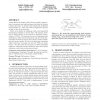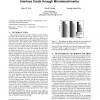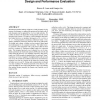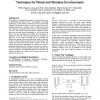SIGMETRICS
2004
ACM
14 years 4 months ago
2004
ACM
The Least Attained Service (LAS) scheduling policy, when used for scheduling packets over the bottleneck link of an Internet path, can greatly reduce the average flow time for sh...
SIGMETRICS
2004
ACM
14 years 4 months ago
2004
ACM
Virtual Private Networks (VPNs) feature notable characteristics in structure and traffic patterns that allow for efficient resource allocation. A strategy that exploits the underl...
SIGMETRICS
2004
ACM
14 years 4 months ago
2004
ACM
Binary search tree (BST) based data structures, such as AVL trees, red-black trees, and splay trees, are often used in system software, such as operating system kernels. Choosing ...
SIGMETRICS
2004
ACM
14 years 4 months ago
2004
ACM
SIGMETRICS
2004
ACM
14 years 4 months ago
2004
ACM
Traditional Peer-to-Peer (P2P) networks do not provide service differentiation and incentive for users. Consequently, users can easily access information without contributing any ...
SIGMETRICS
2004
ACM
14 years 4 months ago
2004
ACM
Measurement studies indicate a high rate of node dynamics in p2p systems. In this paper, we address the question of how high a rate of node dynamics can be supported by structured...
SIGMETRICS
2004
ACM
14 years 4 months ago
2004
ACM
Low priority data transfer across the wide area is useful in several contexts, for example for the dissemination of large files such as OS updates, content distribution or prefet...
SIGMETRICS
2004
ACM
14 years 4 months ago
2004
ACM
The problem of estimating the capacity of an Internet path is one of fundamental importance. Due to the multitude of potential applications, a large number of solutions have been ...
SIGMETRICS
2004
ACM
14 years 4 months ago
2004
ACM
The use of environmental energy is now emerging as a feasible energy source for embedded and wireless computing systems such as sensor networks where manual recharging or replacem...
SIGMETRICS
2004
ACM
14 years 4 months ago
2004
ACM






